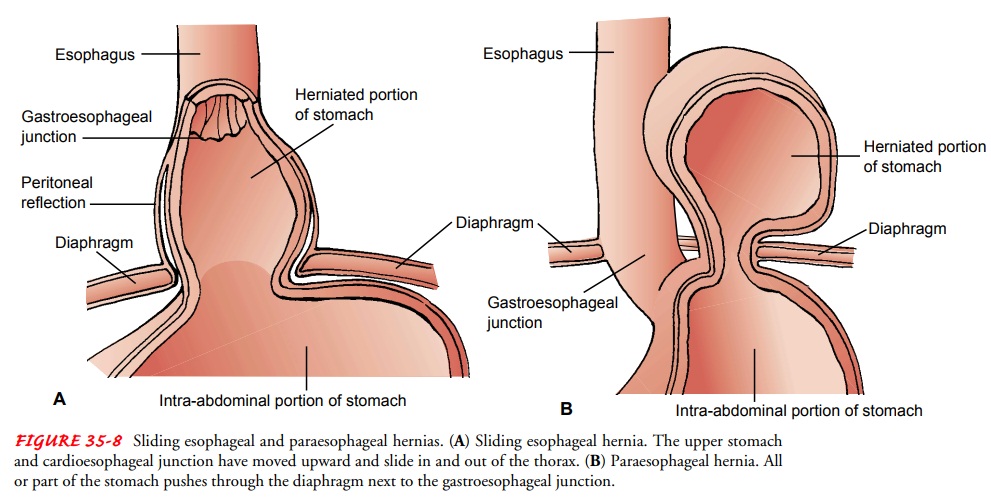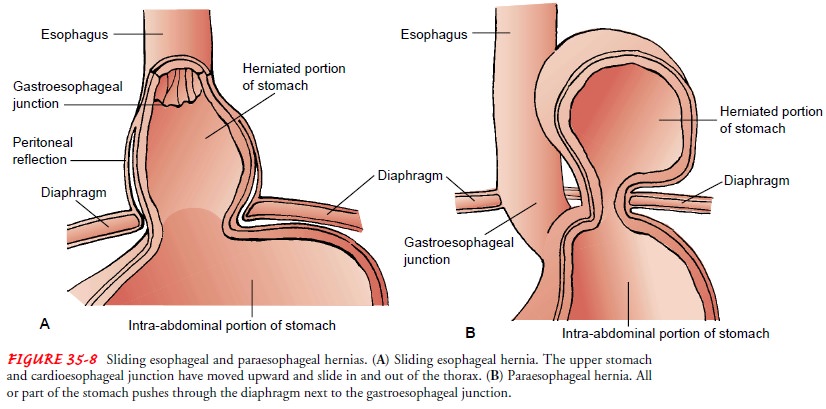Chapter: Medical Surgical Nursing: Management of Patients With Oral and Esophageal Disorders
Hiatal Hernia - Disorders of the Esophagus

HIATAL
HERNIA
The
esophagus enters the abdomen through an opening in the di-aphragm and empties
at its lower end into the upper part of the stomach. Normally, the opening in
the diaphragm encircles the esophagus tightly, and the stomach lies completely
within the ab-domen. In a condition known as hiatus (or hiatal) hernia, the opening in the diaphragm
through which the esophagus passes becomes enlarged, and part of the upper
stomach tends to move up into the lower portion of the thorax. Hiatal hernia
occurs more often in women than men. There are two types of hiatal hernias:
sliding and paraesophageal. Sliding, or type I, hiatal her-nia occurs when the
upper stomach and the gastroesophageal junction (GEJ) are displaced upward and
slide in and out of the thorax (Fig. 35-8A). About 90% of patients with
esophageal hi-atal hernia have a sliding hernia. A paraesophageal hernia occurs
when all or part of the stomach pushes through the diaphragm beside the
esophagus (see Fig. 35-8B). Paraesophageal hernias may be further classified as
types II, III, or IV, depending on the extent of herniation, with type IV
having the greatest herniation.

Clinical Manifestations
The
patient with a sliding hernia may have heartburn, regurgi-tation, and
dysphagia, but at least 50% of patients are asymp-tomatic. Sliding hiatal
hernia is often implicated in reflux. The patient with a paraesophageal hernia
usually feels a sense of full-ness after eating or may be asymptomatic. Reflux
usually does not occur, because the gastroesophageal sphincter is intact. The
complications of hemorrhage, obstruction, and strangulation can occur with any
type of hernia.
Assessment and Diagnostic Findings
Diagnosis
is confirmed by x-ray studies, barium swallow, and fluoroscopy.
Management
Management
for an axial hernia includes frequent, small feedings that can pass easily
through the esophagus. The patient is advised not to recline for 1 hour after
eating, to prevent reflux or move-ment of the hernia, and to elevate the head
of the bed on 4- to 8-inch (10- to 20-cm) blocks to prevent the hernia from
sliding upward. Surgery is indicated in about 15% of patients. Medical and
surgical management of a paraesophageal hernia is similar to that for
gastroesophageal reflux; however, paraesophageal hernias may require emergency
surgery to correct torsion (twisting) of the stomach or other body organ that
leads to restriction of blood flow to that area.
Related Topics